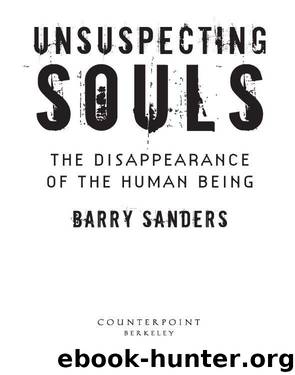Unsuspecting Souls by Barry Sanders

Author:Barry Sanders
Language: eng
Format: epub
Publisher: Counterpoint
Published: 2010-06-01T04:00:00+00:00
A PROMISING STAGE MAGICIAN named Georges Méliès owned the Théâtre Robert-Houdin, in Paris, but when he came across the new cinema, he found a more powerful kind of magic. He very quickly manipulated the mechanics of filmmaking toward what we today would call special effects. Méliès attended the Lumières’ screening of their actualités on December 28, 1895, and the following month bought his own camera, determined to get on film the great magic acts of the period. The connections between magic and film, however, immediately struck him, which led him to exploit in particular the dreamlike quality of motion pictures by using certain techniques like double exposure to create the illusion of people appearing and then quickly disappearing. Born in 1861, Méliès made some five hundred short movies up to 1912, on average almost ten movies a year. He died in 1938. Historians of film rank him as possibly the greatest filmmaker of fantasy and the surreal in all of cinema.
One reviewer credited his films with exploring “transformations and collisions: among humans, objects, animals and various creatures with unearthly powers; between mechanical and natural forces, and, of course (and so pleasurably), between visual styles. Méliès moves in an instant from stage-set realism to storybook phantasm or mechanical animation.” Speed was essential to his technique. To see a Méliès film is to see stage magic miraculously and wonderfully transposed to the screen. More than virtually any other artist, Méliès saw the potential in the medium he had chosen—in the initial senses of “movies” (those which move) and “films” (those which inhabit the ghostly). The innovation of special effects belongs to Georges Méliès.
The public’s interest in disappearance—onstage or in film—reflected a general questioning about the nature of life itself. Literature began to explore reality in its own, ghostly way, cracking life wide open to reveal its wide range of unexpected possibilities. Readers responded. They favored stories in which the central character seemed neither alive nor dead, or sometimes acted like a live human being but then transmogrified into an eerily foreign and frightening creature. Did death really exist as a finality? Or, like the beginnings of life, did it hold its own secrets? The word narcolepsy appears in the English medical journal Lancet, in 1888, to refer to a disease in which an otherwise normal person falls into “short and frequently recurring attacks of somnolence.” Catalepsy, too, appears at the same time, as Poe points out, to mean much the same thing. In a time when all definitions of humanity were up for grabs, neither the beginning nor the end of life had a hard and fast meaning. Victor Frankenstein creates life; Dracula beats death. Dorian Gray thinks he may be dead; Roderick Usher thinks his house may be alive. Life had turned into one grand question.
Mary Shelley, for example, leaves readers in doubt about the exact nature of Doctor Frankenstein’s creation: He resembles a person, although a much larger and much more powerful being than most; but now and again he slips beyond the boundaries of recognizable human behavior.
Download
This site does not store any files on its server. We only index and link to content provided by other sites. Please contact the content providers to delete copyright contents if any and email us, we'll remove relevant links or contents immediately.
The Vikings: Conquering England, France, and Ireland by Wernick Robert(79847)
Ali Pasha, Lion of Ioannina by Eugenia Russell & Eugenia Russell(40109)
The Conquerors (The Winning of America Series Book 3) by Eckert Allan W(37095)
The Vikings: Discoverers of a New World by Wernick Robert(36903)
Cecilia; Or, Memoirs of an Heiress — Volume 1 by Fanny Burney(32396)
Cecilia; Or, Memoirs of an Heiress — Volume 3 by Fanny Burney(31788)
Cecilia; Or, Memoirs of an Heiress — Volume 2 by Fanny Burney(31758)
Empire of the Sikhs by Patwant Singh(22930)
The Secret History by Donna Tartt(18793)
Hans Sturm: A Soldier's Odyssey on the Eastern Front by Gordon Williamson(18448)
Cat's cradle by Kurt Vonnegut(15129)
Pimp by Iceberg Slim(14274)
Sapiens: A Brief History of Humankind by Yuval Noah Harari(14189)
Talking to Strangers by Malcolm Gladwell(13163)
Norse Mythology by Gaiman Neil(13158)
Leonardo da Vinci by Walter Isaacson(13131)
4 3 2 1: A Novel by Paul Auster(12245)
Underground: A Human History of the Worlds Beneath Our Feet by Will Hunt(11992)
The Radium Girls by Kate Moore(11887)
